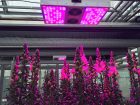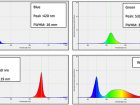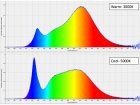
Features
Lighting
Structures & Equipment
Finetuning LEDS for a better light: How light spectrum makes a difference
In part 2 of this two-part series, researchers look at dimmable LEDs in changing light spectra.
June 15, 2018 By Dave Llewellyn and Dr. Youbin Zheng
 The signature magenta colour of many horticultural LED systems comes primarily from red and blue spectral combinations. Zheng Lab
The signature magenta colour of many horticultural LED systems comes primarily from red and blue spectral combinations. Zheng LabIn our last article we examined the potential for saving energy by integrating dimmable horticultural LED lighting systems into various feedback-control strategies. This time, we will review background concepts of LED light spectrum and explore how spectral modifications can be leveraged to improve crop production.
The basics behind LEDs
Quite often we hear questions such as “Are LEDs better than HPS?” and “How do I use LEDs in my operation?”. To answer these types of questions, we need to understand the basics about the light that LEDs produce. It is also important to understand that there can be important differences in the spectral output of different LEDs of a given ‘colour’ (e.g. ‘red’ or ‘blue’). Bare (i.e. uncoated) LEDs are considered monochromatic, meaning each diode produces a single ‘colour’ of light. More accurately, each LED produces a narrow range of wavelengths, and whose spectral power distribution usually follows a bell-shaped curve. LEDs are often characterized according to their peak wavelength (i.e. the highest point on the curve) and the width of the peak at half of the maximum height (dubbed ‘full-width half-maximum’ or FWHM). Since the LEDs used by various manufacturers can have different properties these metrics can help the end-user evaluate different systems they are considering. Figure 1A to 1C demonstrate the typical shapes of the peaks coming from monochromatic blue, red and green LEDs. White LEDs, such as in Figure 1D, are a slightly different type of LED that uses base blue LED underneath a phosphor layer. The phosphor coating, which is similar to the coating on the inside surface of fluorescent lights, broadens the distribution to include longer wavelengths of the visual spectrum. This makes for light output that appears white to the human eye because, like the sun, it has all of the colours of the rainbow. Blue LEDs are used as the base for white, because shorter wavelengths naturally have higher energy (as an aside, this is why short wavelength (<300nm) UV light can cause sunburns but visible light does not). Shorter wavelengths can be converted into lower-energy, longer wavelengths but not vice versa.
It is important to note that ‘white’ LEDs come with many different spectral signatures. They all typically have a blue peak, from the native blue diode, followed by a broad peak over the longer wavelengths in the visible range. The shape of the broadened peak, as well as its size relative to the blue peak controls the colour (we perceive) of the light emitted. The colour of white LEDs is typically defined by its ‘correlated colour temperature’ (CCT), measured in Kelvins (K). For white LEDs, the higher the CCT, the ‘whiter’ the light appears to us. Low CCTs are associated with ‘warm’ light (e.g. incandescent) and high CCTs are associated with ‘cool’ light (e.g. fluorescent). Figure 2 demonstrates the range of colours of light that different ‘white’ LEDs can produce. The spectral power distribution of white LEDs also influences the colour rendering index (CRI), which is a measure of the ability of a light source to reveal an object’s true colours relative to natural light.
Different spectra for different systems
Monochromatic LEDs have unleashed a new era of photobiological research. In a very short period of time, we have observed many interesting light spectrum-mediated phenomena in a myriad of species (and strains/cultivars) during all phases of plant life, including seed germination, vegetative morphology, moderating reproduction and production of secondary metabolites.
While we have just scratched the surface in terms of discovering and characterizing the underlying mechanisms for light spectrum-mediated phenomena, there are some generalizations that are significant for horticultural production. Plant scientists have dubbed the light between 400 to 700 nm as ‘photosynthetically active radiation’ (PAR), as it is largely these wavelengths that contribute to photosynthetic activity. Within the PAR spectrum, the blue (400-500 nm) and red (600-700 nm) wavelengths are commonly known for producing the highest photosynthetic efficiency. As a result, the magenta colour that epitomizes many horticultural LED systems come of primarily red and blue spectral combinations. This research, which was pioneered over 40 years ago (most famously by John McCree), was done primarily on smaller tissues and extracted chloroplasts (organelles that harvest light in plant cells). While the ‘McCree Curve’ argument is commonly used in promotional literature to justify red and blue spectral combinations, they have not necessarily translated into large increases, relative to broader spectrum profiles, in crop productivity metrics found in contemporary scientific literature.
Due to their prevalence, numerous studies have looked at how the ratio of monochromatic blue to red (B:R) light can affect different crops and production scenarios. In general, blue light seems to promote rooting, leads to more compact plants and intensifies colouration (typical of higher anthocyanin production). Of course, different plant species (and even cultivars) can have diverse responses to varied light spectra, including different B:R. For example, our lab’s recent research demonstrated that blue light alone can actually promote plant elongation, similar to some plants’ response to high far red (more on this later). Blue light’s higher energy state (i.e. blue photons have about 30 per cent more energy than red photons) makes blue light inherently less efficient to produce than red light. As a result, while some blue light is (usually) needed for normal plant morphology, lighting manufacturers seem to favour spectral signatures with five to 20 times more red than blue light.
Many horticultural lighting systems now include at least some white LEDs. Regardless of their exact spectral signatures, white LEDs enhance colour rendering which, in turn, enhances visual assessments of crop health (e.g. nutrient disorders and diseases) and may improve worker comfort. Since white LEDs naturally enhance the blue (due to the fundamental colour of the native diode), fixtures that incorporate white LEDs may have fewer or no blue LEDs. Another way to create ‘white’ light is to use green LEDs (such as in Figure 1C) in combination with red and blue. However the development of high-power, energy-efficient green LED technologies is well behind red, blue and white, so green LEDs are not presently common in commercial fixtures. There is also the persistent belief that green light has lower photosynthetic efficiency than red or blue. While this may be true in a test tube of chloroplasts, it has not borne out in some studies with dense plant communities (typical of greenhouse production). Green light can penetrate deeper into the canopy and may actually increase photosynthetic efficiency (relative to red) in lower leaves and result in greater overall biomass production in crops such as lettuce.
Other wavelengths outside of the PAR spectrum are absorbed by specialized plant proteins called ‘photoreceptors’ but do not contribute directly to photosynthesis. These photoreceptors use specific parts of the light spectrum as environmental cues which can stimulate various adaptive responses.
The most well-known signaling wavelengths are far red (FR, 700 to 800 nm) and ultra violet (especially UV, 300 to 400 nm). Both the absolute amount of FR as well as the relative amount of FR compared to R (i.e. the red to far red ratio, R:FR) can have different, but interrelated impacts. A common FR-mediated response is “shade avoidance” which is a set of responses in some plants when exposed to lower ratios of red to far red light that typically happen below a canopy (e.g. on a forest floor) and during daily twilight periods (i.e. at very low solar angles). In floriculture production, typical shade avoidance responses include stretching, reduced branching, and delayed flowering – all of which tend to reduce crop quality. FR has also been associated with increased leaf expansion in seedlings and enhanced flowering in some scenarios. UV light has been shown to enhance the production of photo-protective molecules (a stress response) which can absorb damaging wavelengths. Many of these molecules increase the nutritional and medicinal value of edible plants as well as the attractiveness (darker pigmentation) of ornamentals. Some studies have shown that UV light can also be applied to improve plant tolerance to environmental stresses (e.g. disease, drought, etc.), but more research is needed to explore the underlying mechanisms and to develop protocols for growers to follow.
Spectrally-modifiable horticultural LEDs on the market
Some LED suppliers offer an array of different fixed-spectrum configurations in their product lines. This allows them to target many different commodities and production scenarios (e.g. both greenhouse and sole source) within a common, relatively simple form-factor. For example, Hortilux HortiLED offered by Canada’s P.L. Light Systems and Phillips GreenPower LED are both passively-cooled systems, offered in numerous spectrum configurations (i.e. comprised of various mixes of blue, white, red and far red). Fixture-level dimming is available on some fixed-spectrum fixtures, meaning that intensity can be lowered, but the spectral recipe of a given fixture remains unchanged.
Other manufacturers integrate spectrum-level dimming capabilities into their lights, allowing the end user to modify both the overall intensity level as well as the spectral recipe by adjusting the relative intensities of multiple ‘spectrum channels’ in a single fixture. Some adjustable-spectrum LED systems have manual controls (e.g. knobs) but most modern systems such as Heliospectra’s LX60 and LumiGrow’s PRO325™ and PRO650™ fixtures feature remote control capabilities through on-board electronics, a communications network (wired or wireless) and software applications accessible by PC, tablet or cell phone. This gives the grower the power to adjust the spectral recipe throughout the day or at key points in a production cycle, to evoke a specific morphological or biochemical response. While they are typically more expensive, light fixtures with adjustable spectrum can have advantages over fixtures with fixed spectrum and/or fixed intensity in some greenhouse production scenarios.
Optimizing spectral control for production
The majority of what the scientific community has learned about using LEDs to manipulate crops through spectral modifications has been gleaned from research done in growth chambers. Much of this research is directly applicable to sole-source production scenarios such as indoor cannabis and plant factories, because the operator can choose when and how light is supplied to the crop. However greenhouses have much more complicated lighting dynamics due to the influence of the primary light source: the sun.
Sunlight has relatively equal amounts of photons of every wavelength within the PAR spectrum. While there are spectrum-modifying films on the market, most greenhouse coverings have neutral density (i.e. they don’t change the spectral distribution of PAR, although there are usually reductions in UV).
How can we best leverage the power of LEDs to manipulate crop production in the greenhouse when the presence of copious (but highly variable) background broad-spectrum sunlight will tend to dilute any attempts at spectral manipulation during the daytime? In greenhouse production, spectrum ‘treatments’ are most effectively applied at the ends of the regular photoperiod (i.e. twilight) or during the night. Our group has investigated using end-of-day applications of red light (EodR) to mitigate the shade avoidance response in high-density (and multi-layer) bedding-plant production with mixed results. We have had more success in using twilight applications of R light to control height in Easter lilies.
Another example of using spectrum to manipulate a crop would be to provide high blue light (or UV) during the last few days before harvest to darken the colour of leafy crops such as lettuce and certain ornamentals. We are currently investigating the use of various spectral treatments to elicit specific crop responses (e.g. production of phytonutrients) in microgreens. We are also investigating whether short-term spectrum treatments can be used to enhance specific life stages of microgreens such as promoting seed germination, rooting and stem extension (to facilitate machine harvesting).
Spectral tuning also has tremendous potential for the production of medicinal plants, such as cannabis. We are learning more and more about how different lighting recipes can affect the flowering, yield and phytochemical profiles (e.g. THC, CBD and other compounds) of harvested tissues.
Making the most of LEDs
Horticultural LEDs offer many advantages over traditional HPS technologies. While energy efficiency and extended lifespans may garner the lion’s share of the headlines, capacities for (controlled) dimming and spectral tuning are additional capabilities that can be leveraged in order to get the maximum benefits out of this burgeoning technology.
Dave Llewellyn (dllewell@uoguelph.ca) is a research associate in Dr. Zheng’s lab who has extensive experience working with lighting technologies in research and production environments. This lab has been focusing on lighting research for producing high-value crops (e.g. cannabis, microgreens and ornamentals) for many years. Dr. Youbin Zheng (yzheng@uoguelph.ca) is an environmental horticulture professor at the University of Guelph.
Print this page


